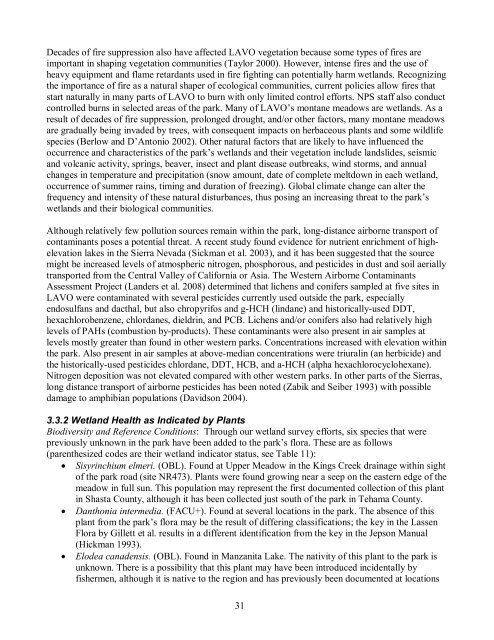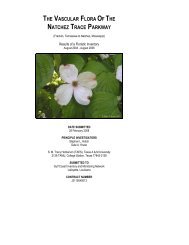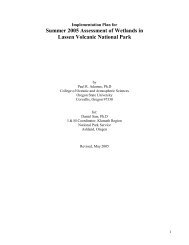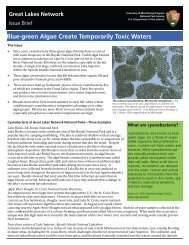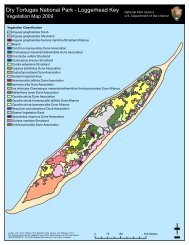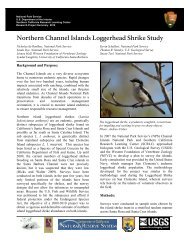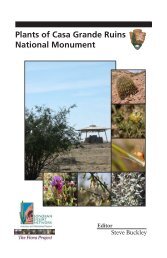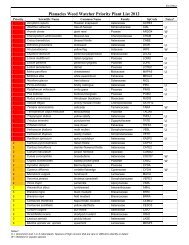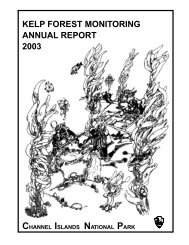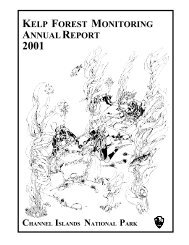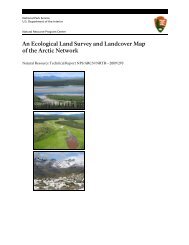Wetlands of Lassen Volcanic National Park - NPS Inventory and ...
Wetlands of Lassen Volcanic National Park - NPS Inventory and ...
Wetlands of Lassen Volcanic National Park - NPS Inventory and ...
You also want an ePaper? Increase the reach of your titles
YUMPU automatically turns print PDFs into web optimized ePapers that Google loves.
Decades <strong>of</strong> fire suppression also have affected LAVO vegetation because some types <strong>of</strong> fires are<br />
important in shaping vegetation communities (Taylor 2000). However, intense fires <strong>and</strong> the use <strong>of</strong><br />
heavy equipment <strong>and</strong> flame retardants used in fire fighting can potentially harm wetl<strong>and</strong>s. Recognizing<br />
the importance <strong>of</strong> fire as a natural shaper <strong>of</strong> ecological communities, current policies allow fires that<br />
start naturally in many parts <strong>of</strong> LAVO to burn with only limited control efforts. <strong>NPS</strong> staff also conduct<br />
controlled burns in selected areas <strong>of</strong> the park. Many <strong>of</strong> LAVO’s montane meadows are wetl<strong>and</strong>s. As a<br />
result <strong>of</strong> decades <strong>of</strong> fire suppression, prolonged drought, <strong>and</strong>/or other factors, many montane meadows<br />
are gradually being invaded by trees, with consequent impacts on herbaceous plants <strong>and</strong> some wildlife<br />
species (Berlow <strong>and</strong> D’Antonio 2002). Other natural factors that are likely to have influenced the<br />
occurrence <strong>and</strong> characteristics <strong>of</strong> the park’s wetl<strong>and</strong>s <strong>and</strong> their vegetation include l<strong>and</strong>slides, seismic<br />
<strong>and</strong> volcanic activity, springs, beaver, insect <strong>and</strong> plant disease outbreaks, wind storms, <strong>and</strong> annual<br />
changes in temperature <strong>and</strong> precipitation (snow amount, date <strong>of</strong> complete meltdown in each wetl<strong>and</strong>,<br />
occurrence <strong>of</strong> summer rains, timing <strong>and</strong> duration <strong>of</strong> freezing). Global climate change can alter the<br />
frequency <strong>and</strong> intensity <strong>of</strong> these natural disturbances, thus posing an increasing threat to the park’s<br />
wetl<strong>and</strong>s <strong>and</strong> their biological communities.<br />
Although relatively few pollution sources remain within the park, longdistance airborne transport <strong>of</strong><br />
contaminants poses a potential threat. A recent study found evidence for nutrient enrichment <strong>of</strong> high<br />
elevation lakes in the Sierra Nevada (Sickman et al. 2003), <strong>and</strong> it has been suggested that the source<br />
might be increased levels <strong>of</strong> atmospheric nitrogen, phosphorous, <strong>and</strong> pesticides in dust <strong>and</strong> soil aerially<br />
transported from the Central Valley <strong>of</strong> California or Asia. The Western Airborne Contaminants<br />
Assessment Project (L<strong>and</strong>ers et al. 2008) determined that lichens <strong>and</strong> conifers sampled at five sites in<br />
LAVO were contaminated with several pesticides currently used outside the park, especially<br />
endosulfans <strong>and</strong> dacthal, but also chropyrifos <strong>and</strong> gHCH (lindane) <strong>and</strong> historicallyused DDT,<br />
hexachlorobenzene, chlordanes, dieldrin, <strong>and</strong> PCB. Lichens <strong>and</strong>/or conifers also had relatively high<br />
levels <strong>of</strong> PAHs (combustion byproducts). These contaminants were also present in air samples at<br />
levels mostly greater than found in other western parks. Concentrations increased with elevation within<br />
the park. Also present in air samples at abovemedian concentrations were triuralin (an herbicide) <strong>and</strong><br />
the historicallyused pesticides chlordane, DDT, HCB, <strong>and</strong> aHCH (alpha hexachlorocyclohexane).<br />
Nitrogen deposition was not elevated compared with other western parks. In other parts <strong>of</strong> the Sierras,<br />
long distance transport <strong>of</strong> airborne pesticides has been noted (Zabik <strong>and</strong> Seiber 1993) with possible<br />
damage to amphibian populations (Davidson 2004).<br />
3.3.2 Wetl<strong>and</strong> Health as Indicated by Plants<br />
Biodiversity <strong>and</strong> Reference Conditions: Through our wetl<strong>and</strong> survey efforts, six species that were<br />
previously unknown in the park have been added to the park’s flora. These are as follows<br />
(parenthesized codes are their wetl<strong>and</strong> indicator status, see Table 11):<br />
• Sisyrinchium elmeri. (OBL). Found at Upper Meadow in the Kings Creek drainage within sight<br />
<strong>of</strong> the park road (site NR473). Plants were found growing near a seep on the eastern edge <strong>of</strong> the<br />
meadow in full sun. This population may represent the first documented collection <strong>of</strong> this plant<br />
in Shasta County, although it has been collected just south <strong>of</strong> the park in Tehama County.<br />
• Danthonia intermedia. (FACU+). Found at several locations in the park. The absence <strong>of</strong> this<br />
plant from the park’s flora may be the result <strong>of</strong> differing classifications; the key in the <strong>Lassen</strong><br />
Flora by Gillett et al. results in a different identification from the key in the Jepson Manual<br />
(Hickman 1993).<br />
• Elodea canadensis. (OBL). Found in Manzanita Lake. The nativity <strong>of</strong> this plant to the park is<br />
unknown. There is a possibility that this plant may have been introduced incidentally by<br />
fishermen, although it is native to the region <strong>and</strong> has previously been documented at locations<br />
31


